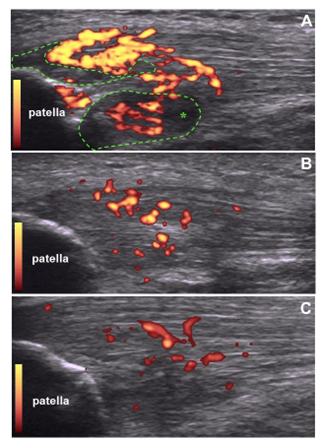MOJ
eISSN: 2381-179X


Case Report Volume 7 Issue 3
1Universidad Alfonso X el Sabio, Spain
2Mutualidad de Previsi
3Servicio de Histolog
4Departamento de Estructura y Funci
Correspondence: Pedro Cuevas, Facultad de Medicina, Universidad Alfonso X el Sabio, 28691-Villanueva de la Cañada, Spain
Received: August 24, 2017 | Published: August 29, 2017
Citation: Cuevas P, Rodas JA, Angulo J, et al. Short-term efficacy of etamsylate injection in chronic patellar tendinopathy. MOJ Clin Med Case Rep. 2017;7(3):217-218. DOI: 10.15406/mojcr.2017.07.00200
Chronic patellar tendinopathy is one of the most common overuse knee disorders. Etamsylate injection, performed in the peritendinous tissue of chronic patellar tendinosis resulted in reduction of pain and pathologic neovascularization with improvement of leg function, after four weeks of treatment.
Keywords: patellar tendinosis, etamsylate injection, fibroblast growth factor
A 35-old year healthy Caucasian football player man presented with a 3years history of anterior knee pain and tenderness in his right patellar tendon insertion. He referred a constant dull aching pain with walking, forcing to discontinue sport because of the severity of his pain. He has been previously treated with conservative therapy and with platelet-rich plasma (PRP) injections; however his pain did not improve. At presentation, pain was rated as 7 out of 10 on Visual Analogue Scale (VAS). Color Doppler ultrasound examination revealed signs of tendinosis with significant neovascularity, formed by immature tortuous and dilated vessels into intratendinous mass (Figure 1A). Furthermore, color Doppler scans showed areas of intratendinousedema in the proximal patellar-tendon interface (Figure 1A). After discussing the various treatment options, the patient opted to try etamsylate injection and signed an informed consent. Lidocaine was infiltrated into the skin overlying the right patellar tendon. 4ml etamsylate (Dicynone®, Sanofi-Aventis. France) were injected under ultrasound guidance into peritendinous patellar tendon tissue. The procedure was uneventful. At 2weeks follow-up visit, patient reported a marked improvement of his pain (VAS was rated as 2), and color Doppler ultrasound scans showed a significant reduction of neovessels and disappearance of tendinous edema (Figure 1B). Furthermore, at 4weeks tendon hypervascularity decreased (Figure 1C) and pain strongly ameliorated (VAS=1). Patient could return to his previous level of sport without any restrictions.

Patellar tendinosis is a common painful difficult-to-treat overuse injury of the patellar tendon with a negative impact on the carriers of many athletes. The overall prevalence of patellar tendinopathy yields to 14% in elite athletes and increases up to 45% in high-risk sports such as basketball and volleyball.1 There are a wide variety of treatment options available, the majority of which are non-operative. No consensus exists on the optimal method of treatment. Anti-inflammatories and injectable agents have shown mixed results.2 In approximately 10% of conservatively treated patients, conservative treatment fails and surgery is required.3 Since tendinopathy appears to be a highly active process of ongoing neovascularization, anti-angiogenic therapies could be a new approach for treating tendinopathies.4 It has been reported that nerves appear to travel in close association to tendon neovessels.5 This finding suggests that angiogenesis plays an important role in pain-experienced in tendinopathy condition.6,7 These data are in accordance with clinical studies showing that strategies to destroy neovessels (i.e local injection of a sclerosing agent, polidocanol) lead to pain improvement.7 Etamsylate, an inhibitor of fibroblast growth factor (FGF), when locally applied, supresses FGF-driven angiogenesis.8,9 Since FGF participates in nociception,10,11 injecting etamsylate into the areas of tendon neovascularization could not only decrease the number of pathologic neovessels, but also eradicate the pain-generation nerve fibres. In conclusion, therapeutic modulation of neovascularization by influencing the levels of FGF might be a promising target for new approaches in tendinopathies.
None.
The author declares no conflict of interest.

©2017 Cuevas, et al. This is an open access article distributed under the terms of the, which permits unrestricted use, distribution, and build upon your work non-commercially.